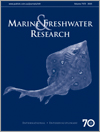Marine and Freshwater Research
Volume 71
Number 7 2020
Gammarus roeselii is one of the successful non-indigenous species recently established in the Ticino River basin. In this study we assessed the spatial distribution of this amphipod in the secondary hydrographic system of the southern part of the sub-lacustrine Ticino River basin and examined substrate preferences on the basis of laboratory experiments.
The effects of climate on fish in the Bohai Sea and Yellow Sea were evaluated, and highly vulnerable fish species were identified. Nearly half the dominant fish species were highly vulnerable, whereas 84% of species were at high impact risk. Miichthys miiuy was found to have the highest impact risk, whereas Acropoma japonicum had the lowest. Demersal fishes tended to be more vulnerable than pelagic fishes.
This study revealed differences in the ecological role of soft-substrate tide pools between estuary and coastal tidal flats. The different types of tidal flat play different roles for groups of transient species, but similar roles for residents. Accordingly, we should consider not only species diversity, but also habitat use patterns of individual species through their life history when evaluating habitat value.
Impoundment of the Yangtze River formed the largest reservoir in the world and led to spatial and seasonal fluctuations in food availability for native fish. In less than a decade, dietary plasticity facilitated the adaptation of three generalist catfish species to the novel habitats formed by the dam. This study enhances understanding of mechanisms that allow generalist species to maintain co-occurring populations in such dramatically changing habitats.
The diet composition of silver carp and bighead carp in two lakes with varying productivity was investigated by high-throughput sequencing analysis. Silver carp feed primarily on phytoplankton and exhibit feeding selectivity. Bighead carp feed primarily on zooplankton, but exhibit a dietary shift to phytoplankton with increasing levels of algae. Gaining knowledge of the feeding habits of planktivorous fish can provide insights into the management of water eutrophication problems.
We describe the structure of eight remnant Sydney rock oyster (Saccostrea glomerata) reefs and estimate the density, biomass, productivity and composition of mobile macroinvertebrate and infaunal communities associated with them. The oyster reefs had a distinct assemblage of macroinvertebrates, with fivefold higher biomass and almost fivefold higher productivity than adjacent bare sediments.
Trochus are large tropical marine snails that are collected across the Indo-Pacific region for their beautiful mother of pearl shells, but are often overharvested. This investigation used genetics to measure how often trochus larvae are transported between coastal reefs and offshore atolls in north-western Australia. Results confirm that such movement is rare, and so separate management of these regions is appropriate.
A review of trace elements and hydrocarbon contamination in Australian sea port environments revealed marked trace metal (As, Cu, Pb, Cd, Zn and Ni) contamination in the water and sediments of Port Derwent, Port Kembla, Port Botany Bay and Port Newcastle, and polychlorinated biphenyls, dichlorodiphenyltrichloroethane and chlordane contamination in the aquatic biota at Port Jackson and Port Brisbane.
Indigo barb Pethia setnai is one of the endemic fish species present in the Western Ghats of India. This species is currently exploited from the wild for the ornamental fish trade. This study is the first report of the population dynamics of this endemic cyprinid and will help in planning future sustainable management practices.
We compared aquatic leaf breakdown between an arboreal and a grass species in two streams of the Brazilian Atlantic Forest, one draining mostly forests and the other draining mostly pasture lands. Grass breakdown was faster than that of arboreal plants in the forest stream, but not in the pasture stream. In both streams, aquatic invertebrates assimilated more forest leaves than grass leaves.
In the past two decades, half of the once oligotrophic lakes of Montebello, Chiapas, have been affected by eutrophication, which has led to many changes in water quality and ecological interactions. We found a marked change in dominance in turbid lakes and that the relationship between turbidity and richness is unimodal, consistent with the intermediate productivity theory.
The first record of azaspiracid (AZA)-2 in plankton samples from Argentinean waters is presented herein, together with the first detection of Azadinium obesum in the southern hemisphere and four other Azadinium species, of which two are potentially toxigenic. The diversity, wide latitudinal distribution and high abundances of Azadinium plus the detection of AZA-2 found in this study highlights the potential risk of AZA shellfish contamination episodes in the south-west Atlantic Ocean.
The witch guitarfish is caught incidentally in bottom trawl nets used in the shrimp fishery in the Gulf of Tehuantepec. Adults are probably concentrated at depths >60 m in the Gulf of Tehuantepec during most of the year and migrate towards shallow waters (from 25 to 37 m) to reproduce in February. The incidental catch of witch guitarfish during its reproductive cycle using bottom trawl nets could negatively affect the reproductive success and long-term viability of this species.
We provide the first age, growth and age at sexual maturity estimates of the herbivorous fish Kyphosus bigibbus, which is widely distributed in all oceans. By improving techniques for otolith section preparation, we estimated age more accurately than by using scales. This species has a long reproductive lifespan, and recruitment may increase rapidly after noticeable losses of kelp forests.





